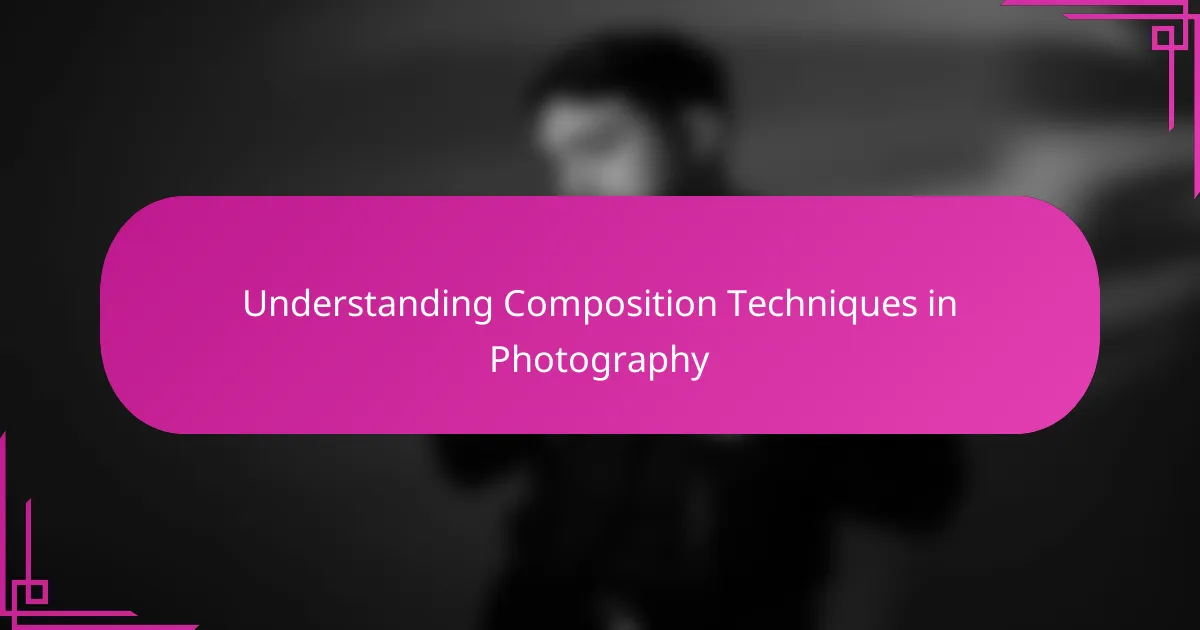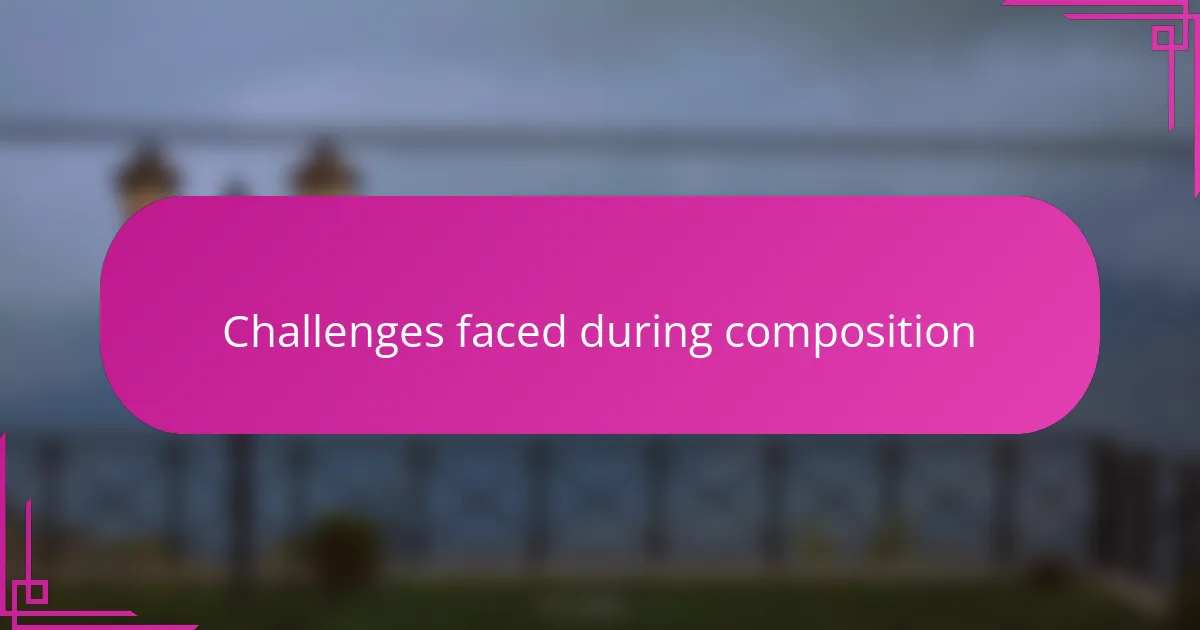Key takeaways
- Composition techniques such as the rule of thirds and leading lines enhance storytelling in photography, allowing for emotional resonance in images.
- Embracing negative space and focusing on balance between elements can create calm and impactful visuals, especially in urban settings.
- Flexibility and patience are essential; adapting to spontaneous elements often leads to more genuine and lively photographs.
- Exploring different perspectives within a space, like Central Park, can uncover unique compositions and enhance the overall dynamism of images.

Understanding composition techniques in photography
Composition techniques in photography are like the blueprint that guides our eyes through the image. When I first tried to grasp these concepts, I wondered why some photos just felt right while others fell flat, and it hit me—composition is the invisible hand shaping that feeling.
I noticed early on that simple rules like the rule of thirds or leading lines aren’t just tricks but tools that allow me to tell a story with every frame. For instance, at Central Park, using natural lines from pathways helped me draw attention to quiet moments, making my pictures more than just snapshots—they became visual narratives.
Have you ever thought about why certain images keep pulling you back in? For me, it’s the balance between elements and the way space is managed within the frame. Understanding that balance taught me to see photography not just as capturing reality but as crafting something that resonates emotionally.

Key composition rules for landscape photos
One key rule I leaned on during my shoot at Central Park was the rule of thirds. By imagining the frame split into a tic-tac-toe grid, I placed important elements like a lone tree or a bench along those lines. It felt like suddenly the scene had a natural rhythm, making my photos feel more alive and inviting.
I also discovered how leading lines can subtly guide the viewer’s eye. Walking along the winding pathways, I’d position myself so these lines pointed toward a focal point, like a distant bridge or a patch of sunlight filtering through the trees. It made me realize how composition isn’t just about what’s in the photo, but where things lead you emotionally.
Have you ever noticed how an empty space in an image can say as much as the subject itself? Embracing negative space helped me highlight the peacefulness of Central Park’s vast lawns. That quietness brought out a calm feeling in my photos, and I found that sometimes less really is more when telling a story visually.

Importance of composition in urban settings
Urban settings like Central Park buzz with energy and complexity, which makes composition all the more crucial. I quickly realized that without thoughtful framing, the chaos of city life can overwhelm the story I wanted to tell through my lens.
Have you ever tried capturing a busy street and felt your photo was just noise? For me, composition became the tool to tame that noise—organizing people, buildings, and light into a harmonious visual flow. It’s what transforms a cluttered scene into a compelling image that communicates mood and movement.
What truly strikes me is how composition allows me to find pockets of calm or unexpected beauty amidst the urban rush. By framing just the right elements, I could show not only the physical space but also the emotions woven into the city’s rhythm. It’s a creative challenge I’ve grown to love.

Applying techniques at Central Park
Applying composition techniques at Central Park was like putting theory into motion. I found myself constantly adjusting my angle or stepping back to let the natural lines of the park’s trails lead the viewer’s eye exactly where I wanted. Have you ever felt that moment where everything just clicks—the light, the scene, the frame? At Central Park, it happened more than once.
One particular afternoon, I focused on balancing foreground elements with the sprawling skyline in the background. It wasn’t just about getting everything in the shot, but about creating layers that invited the viewer to wander through the image. That sense of depth made my photos feel more immersive, as if someone could step right into the scene.
I also learned to embrace imperfections, like a stray pedestrian or shifting shadows, by using them as part of the composition rather than distractions. These unexpected touches added life and authenticity to my shots. Have you noticed how a fleeting moment often tells the most genuine story? Central Park became the perfect stage for that kind of storytelling through composition.

Challenges faced during composition
Sometimes, the biggest challenge I faced during composition at Central Park was dealing with unpredictable elements—like a sudden crowd or shifting light—that threatened to throw off my carefully planned frame. Have you ever tried to capture a quiet moment, only to have a group of joggers dash through just as you press the shutter? Those moments tested my patience but also taught me to embrace spontaneity.
I also struggled with finding the right balance between foreground and background. At times, I felt torn between highlighting a striking tree up close versus including the sprawling skyline behind it. How do you decide what deserves the viewer’s attention without making the image feel cluttered? It took several attempts before I understood that sometimes less is more, and prioritizing one element can create a stronger impact.
Another challenge was resisting the urge to overcomplicate my compositions. With so many details around me—the winding paths, benches, flowers—it was tempting to include everything. But I found myself asking: does every element add to the story, or does it distract? Learning to simplify, to let certain parts breathe, was a breakthrough that made my photos more powerful and inviting.

Personal insights and learning experiences
I quickly realized that composition isn’t just about rules printed in a book; it’s about feeling the scene and responding to it. There was this one morning when the soft light hit the trees just right, and I instinctively framed the shot to include a winding path—something that felt natural rather than forced. That moment taught me that intuition plays a huge role alongside technique.
Have you ever been frustrated trying to get the “perfect” shot, only to see something unexpected change the scene? At Central Park, I often found spontaneous elements, like a child chasing pigeons or leaves swirling in the breeze, that challenged my original plans. Instead of fighting these interruptions, I learned to welcome them—they often brought a genuine life to my photos I hadn’t anticipated.
Learning to balance patience with flexibility was one of my biggest takeaways. I’d spend time carefully composing a frame, then moments later find the light shifted or people moved through the scene. Those experiences taught me that great composition isn’t static; it’s about adapting and finding storytelling moments in the ebb and flow of the environment. Isn’t that what makes photography so exciting?

Tips for photographers visiting Central Park
One tip I always keep in mind when shooting at Central Park is to arrive early. The soft morning light creates a magical atmosphere, and fewer visitors mean I can experiment freely with composition without distractions. Have you ever noticed how the same spot feels completely different at dawn compared to midday? That quiet time gave me the chance to connect deeply with the scene.
Another thing I found helpful was to move around a lot—literally walk the space. Central Park offers so many unique angles, from hidden bridges to peaceful ponds, and sometimes the perfect composition isn’t where you first stand. When I took the time to explore, I uncovered surprising perspectives that made my photos more dynamic. Don’t be afraid to get low or climb slightly higher; changing your viewpoint can transform an ordinary shot into something memorable.
Finally, patience plays a huge role at a place as lively as Central Park. I often waited for the right moment when light, shadow, and people aligned naturally. Have you experienced that instant when a passerby unknowingly enhances your frame, adding life and story? Embracing these fleeting interactions taught me that sometimes the best compositions come from being present and ready to capture the unexpected.